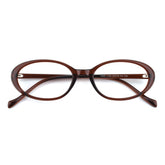What is cylinder(cyl) in eye prescription?
When you receive an eye prescription, it can often look like a jumble of numbers and abbreviations. One of the key components you might see is "Cylinder" or "CYL." Understanding what this term means is crucial to grasping how your vision is being corrected and what type of lenses you need.

- What does it mean when you has Cylinder(CYL) in your prescription?
- What is Cylinder (CYL) in an Eye Prescription?
- How CYL works in correcting astigmatism?
- Why there are positive and negative CYL values?
- Why CYL Matters?
1 What does it mean when you has Cylinder(CYL) in your prescription?
Before diving into what Cylinder (CYL) means, it’s important to understand astigmatism. If you’ve ever noticed that street lights at night appear as long, stretched lines instead of clear points of light, as shown in the image below, you might have astigmatism. This condition causes blurry and distorted vision due to an irregularly shaped cornea or lens.

To correct this visual issue, your eye doctor will include Cylinder (CYL) and Axis values in your prescription. The Cylinder value indicates the lens power needed to correct the astigmatism, while the Axis specifies the orientation of the correction.
2 What is Cylinder (CYL) in an Eye Prescription?
Cylinder (CYL) in an eye prescription refers to the amount of lens power needed to correct astigmatism. Astigmatism is a refractive error caused by an irregularly shaped cornea or lens. Instead of being perfectly round, the cornea is more oval-shaped, causing light to focus on multiple points on the retina rather than just one. This can lead to blurred or distorted vision.
The CYL value in your prescription indicates how much correction is required to address this uneven curvature. The higher the CYL number, the more significant the astigmatism. If there is no CYL value on your prescription, it means you do not have astigmatism, or it is so minimal that it doesn't require correction.
3 How CYL works in correcting astigmatism?
The CYL value alone doesn't fully correct astigmatism; it works in tandem with another value called the "Axis." The Axis number, which ranges from 1 to 180 degrees, indicates the direction or orientation of the astigmatism on your cornea. Together, the CYL and Axis numbers ensure that the corrective lenses you receive address both the strength and direction of your astigmatism.
For example, a prescription might look like this:
CYL: -2.00 Axis: 180
This means that your lenses need to correct 2 diopters of astigmatism along the 180-degree meridian of your cornea.
4 Why there are positive and negative CYL values?
CYL values can be either positive (+) or negative (-). A negative CYL value is typically used in most prescriptions, particularly in the U.S., and indicates that the lens needs to correct for myopic (nearsighted) astigmatism. A positive CYL value is less common and corrects for hyperopic (farsighted) astigmatism. Your eye care professional will determine the exact value based on your specific vision needs.
5 Why CYL Matters?
Understanding your CYL value is crucial because it helps ensure your eyeglasses or contact lenses are tailored to correct your specific type of astigmatism. If the CYL value is incorrect or missing, your vision might remain blurry or distorted even with corrective lenses. Accurate CYL and Axis values are essential for sharp, clear vision and for reducing symptoms like eye strain and headaches associated with astigmatism.
In summary, the Cylinder (CYL) value in your eye prescription is key to correcting astigmatism, ensuring that light is properly focused on your retina, and providing you with the clearest vision possible.











